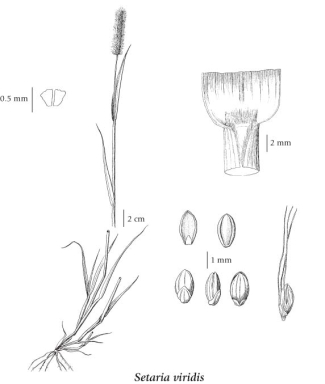Setaria viridis (L.) P. Beauv.
green bristlegrass
Poaceae (Grass family)
Introduction to Vascular Plants
green bristlegrass
Poaceae (Grass family)
Introduction to Vascular Plants
SUBTAXA PRESENT IN BC
Species Information
General:
Annual grass from fibrous roots, basally branching; stems decumbent to erect, 10-100 cm tall.
Leaves:
Sheaths keeled, smooth; blades flat to folded, 4-11 mm wide, smooth or fringed with soft fine hairs at the throats, the collars slightly hairy or smooth; ligules scarcely 2 mm long, fringed with fine hairs.
Flowers:
Inflorescence a rather narrow, cylindrical panicle, not obviously lobed, rarely over 10 cm long, 15 mm wide when pressed; spikelets 2-flowered, 3-3.6 mm long, each subtended by 2 or 3 (4), rough bristles that are up to 3 times as long as the spikelets, the hairs directed upwards; lower flowers staminate or sterile, the upper fertile; fertile lemmas and paleas nearly completely enclosed by the upper glumes and sterile lemmas, and not shed separately from them, usually evidently cross-wrinkled when mature.
Notes:
Closely related to S. italica.
Illustration

If more than one illustration is available for a species (e.g., separate illustrations were provided for two subspecies) then links to the separate images will be provided below. Note that individual subspecies or varietal illustrations are not always available.
Illustration Source: The Illustrated Flora of British Columbia
Ecology
Ecological Framework for Setaria viridis
The table below shows the species-specific information calculated from
original data (BEC database) provided by the BC Ministry of Forests and Range.
(Updated August, 2013)
The table below shows the species-specific information calculated from
original data (BEC database) provided by the BC Ministry of Forests and Range.
(Updated August, 2013)
| Site Information |
Value / Class |
||
|
Avg |
Min |
Max |
|
| Elevation
(metres) |
968 | 968 | 968 |
| Slope
Gradient (%) |
0 | 0 | 0 |
|
Aspect (degrees) |
0 | ||
| Soil
Moisture Regime (SMR) [0 - very xeric; 4 - mesic; 8 - hydric] |
1 | 1 | 1 |
| Modal
Nutrient Regime
Class |
B | ||
| #
of field plots species was recorded in: |
1 | ||
| Modal
BEC Zone Class |
ICH | ||
|
All BEC Zones (# of stations/zone) species was recorded in |
ICH(1) | ||
|
Source:
Klinkenberg 2013
|
|||
Habitat and Range
Mesic to dry fields, roadsides and waste areas in the lowland, steppe and montane zones; frequent in S BC; introduced from Eurasia.Status Information
| Scientific Name | Origin Status | Provincial Status | BC List (Red Blue List) | COSEWIC |
|---|---|---|---|---|
| Setaria viridis var. major | Exotic | SNA (2018) | Exotic | Not Listed |
| Setaria viridis var. viridis | Exotic | SNA (2000) | Exotic | Not Listed |
BC Ministry of Environment: BC Species and Ecosystems Explorer.
Similar Species
Setaria viridis is difficult to distinguish from Setaria faberi (Pohl 1962). Dore and McNeill (1980) and Pohl (1962) indicate that S. viridis is primarily glabrous while S. faberi usually has hairs on the upper surface of the leaf blades. Pohl says "The prevalent form of S. faberia bears soft pubescence on the upper leaf surfaces only and is usually distinguished from other species on this basis." However, leaf pubescence is not always a reliable character, in general; features of the spikelets may be more reliable separators (Pohl 1962).
|
Taxonomic Keys
View a comparative photo of Setaria viridis, S. glauca and S. faberi.
|
References
Dore, William G. and J. McNeill. 1980. Grasses of Ontario. Agriculture Canada. Monograph 26. Ottawa.
Pohl, Richard W. 1962. Notes on Setaria faberi and S. viridis (Gramineae). Brittonia 14 (2): 210-213 .